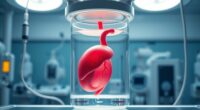Programmable probiotics are specially engineered microbes that can detect, diagnose, and treat chronic diseases with precision. They respond to specific signals in the body’s microenvironments, producing diagnostic markers or therapeutic proteins like enzymes to reduce inflammation or combat disease. These probiotics can be protected during delivery with bioinspired coatings, ensuring they reach their targets effectively. If you keep exploring, you’ll discover how these innovative solutions could transform health management and therapy.
Key Takeaways
- Engineered probiotics utilize synthetic gene circuits for targeted detection and response within specific disease microenvironments.
- They enable noninvasive diagnostics by producing visible signals measurable in urine or bodily fluids.
- Probiotics can produce therapeutic proteins like antioxidants to reduce inflammation and promote tissue healing.
- Protective coatings enhance probiotic survival during gastrointestinal transit, ensuring effective delivery to diseased sites.
- Combining diagnostics and therapy, programmable probiotics offer a precise, minimally invasive approach to managing chronic diseases.

Have you ever imagined probiotics that do more than just support gut health? Today’s scientists are engineering programmable probiotics capable of targeted disease detection and therapy, transforming how we approach chronic illnesses. These probiotics, like Escherichia coli Nissle 1917 (EcN), are customized with synthetic gene circuits that respond to specific microenvironments within the body. By integrating expression cassettes—such as those producing luminescence (luxCDABE) or enzymatic signals (lacZ)—these bacteria can generate multifunctional outputs visible in vitro and in vivo. This means they can signal the presence of disease directly within the body, providing real-time diagnostics. Utilizing synthetic biology techniques, researchers are able to precisely design these microbial systems for specific medical applications.
Programmable probiotics with synthetic gene circuits enable real-time disease detection and targeted therapy inside the body.
You can control these probiotic functions with inducible systems, like IPTG-triggered lacZ expression. This allows precise regulation of diagnostic signals, guaranteeing they activate only under certain conditions, which minimizes false positives. Additionally, stable plasmid maintenance systems ensure these engineered bacteria retain their genetic modifications over time, maintaining their diagnostic and therapeutic capabilities during prolonged use. This stability enables these probiotics to selectively colonize diseased tissue areas, like liver metastases, where they can deliver signals or therapy right at the disease site.
One of the most promising applications is in cancer detection. These probiotics can selectively accumulate in metastatic tumors, sometimes enriching up to a million-fold compared to healthy tissue. They produce detectable reporter signals—like enzymatic activity that can be measured in urine—allowing noninvasive, simple detection of small metastases. Imagine being able to identify cancer early through a urine test after oral probiotic administration, with no adverse effects observed in animal models over long periods. This approach could vastly improve current diagnostic methods, which often fail to detect small or early-stage tumors.
Beyond detection, programmable probiotics can produce therapeutic proteins directly within the body. For example, they can generate enzymes such as catalase (CAT) and superoxide dismutase (SOD) that scavenge harmful reactive oxygen species (ROS). This reduces inflammation and protects tissues from cell death, especially in inflammatory conditions like inflammatory bowel disease (IBD). These probiotics upregulate protective proteins, decrease pro-inflammatory cytokines, and boost anti-inflammatory responses—leading to faster tissue recovery and symptom relief in animal models. This multifunctional approach offers a new dimension to probiotic therapy, combining diagnostics with targeted treatment.
To make sure these engineered bacteria reach their targets alive, scientists have developed bioinspired coatings, like chitosan and sodium alginate, which shield probiotics from stomach acid and bile salts during digestion. These coatings form a barrier that helps probiotics survive transit through the gastrointestinal tract, guaranteeing they arrive functional and ready to act. This protection boosts the reliability of probiotic delivery, vital for both diagnostics and therapy. Overall, programmable probiotics hold the potential to revolutionize treatment strategies for chronic diseases, making interventions more precise, less invasive, and highly adaptable.
Frequently Asked Questions
How Do Programmable Probiotics Differ From Traditional Probiotics?
You might wonder how programmable probiotics differ from traditional ones. They’re engineered with synthetic gene circuits, allowing you to control their activity, produce diagnostic signals, and deliver targeted therapies. Unlike traditional probiotics, which act broadly and continuously, programmable strains respond to specific cues, activate or deactivate functions, and can be tailored for precise disease detection and treatment. This advanced control makes them more versatile and effective in managing complex health conditions.
What Are the Safety Concerns Associated With Programmable Probiotics?
Imagine programming a tiny robot inside your gut—sounds promising, but risks exist. You might inadvertently introduce harmful genes or trigger infections, especially if your immune system’s weakened. Data shows probiotic-related infections in vulnerable groups, and gene transfer remains a concern. You need strict safety measures, thorough testing, and regulation to guarantee these engineered microbes don’t cause unintended harm, much like handling delicate machinery.
Can Programmable Probiotics Be Personalized for Individual Patients?
Yes, programmable probiotics can definitely be personalized for individual patients. You can use advanced tools like genomics, metabolomics, and AI platforms to analyze your gut microbiota. This information helps tailor probiotic strains with precise genetic modifications, ensuring they suit your unique microbiome. Combining personalized nutrition and targeted delivery systems further enhances effectiveness, making these probiotics a customized approach to improve your health and manage specific chronic conditions effectively.
How Long Does It Take for Programmable Probiotics to Show Effects?
You might wonder how long it takes for probiotics to work. Studies show some gut health improvements occur within just a few days, but more significant benefits often take several weeks to months. Your response depends on factors like the probiotic strain, your microbiome, and health condition. Consistent use is key, and patience pays off as these tailored probiotics gradually support your immune system and overall health.
Are There Any Regulatory Approvals for Programmable Probiotic Therapies?
Right now, there are no approved programmable probiotic therapies. You should know that most are still in early research or clinical trials, with regulatory agencies treating them differently from traditional probiotics. They pose unique safety and efficacy challenges, so gaining approval takes time and rigorous testing. As research advances, clearer standards and frameworks are emerging, but you won’t find any fully approved programmable probiotic treatments on the market yet.
Conclusion
With programmable probiotics, you can harness the power of precision, personalize your health, and transform your approach to chronic diseases. They offer targeted solutions, adaptable to your unique needs, and open the door to innovative treatments. By embracing this technology, you not only take control of your well-being but also pave the way for a healthier future. Programmable probiotics empower you to fight, to heal, and to thrive—because your health deserves the best of science and nature combined.










